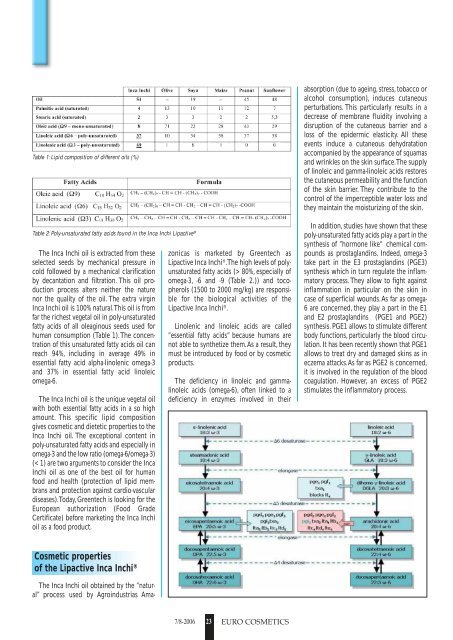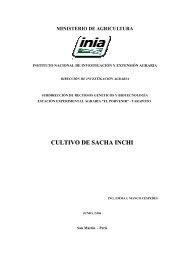Create successful ePaper yourself
Turn your PDF publications into a flip-book with our unique Google optimized e-Paper software.
Table 1: Lipid composition of different oils (%)<br />
Table 2: Poly-unsaturated fatty acids found in the Inca Inchi Lipactive ®<br />
The Inca Inchi oil is extracted from these<br />
selected seeds by mechanical pressure in<br />
cold followed by a mechanical clarification<br />
by decantation and filtration. This oil production<br />
process alters neither the nature<br />
nor the quality of the oil. The extra virgin<br />
Inca Inchi oil is 100% natural.This oil is from<br />
far the richest vegetal oil in poly-unsaturated<br />
fatty acids of all oleaginous seeds used for<br />
human consumption (Table 1).The concentration<br />
of this unsaturated fatty acids oil can<br />
reach 94%, including in average 49% in<br />
essential fatty acid alpha-linolenic omega-3<br />
and 37% in essential fatty acid linoleic<br />
omega-6.<br />
The Inca Inchi oil is the unique vegetal oil<br />
with both essential fatty acids in a so high<br />
amount. This specific lipid composition<br />
gives cosmetic and dietetic properties to the<br />
Inca Inchi oil. The exceptional content in<br />
poly-unsaturated fatty acids and especially in<br />
omega-3 and the low ratio (omega-6/omega-3)<br />
(< 1) are two arguments to consider the Inca<br />
Inchi oil as one of the best oil for human<br />
food and health (protection of lipid membrans<br />
and protection against cardio-vascular<br />
diseases).Today, Greentech is looking for the<br />
European authorization (Food Grade<br />
Certificate) before marketing the Inca Inchi<br />
oil as a food product.<br />
Cosmetic properties<br />
of the Lipactive Inca Inchi ®<br />
The Inca Inchi oil obtained by the ”natural”<br />
process used by Agroindustrias Ama-<br />
zonicas is marketed by Greentech as<br />
Lipactive Inca Inchi ® .The high levels of polyunsaturated<br />
fatty acids (> 80%, especially of<br />
omega-3, -6 and -9 (Table 2.)) and tocopherols<br />
(1500 to 2000 mg/kg) are responsible<br />
for the biological activities of the<br />
Lipactive Inca Inchi ® .<br />
Linolenic and linoleic acids are called<br />
”essential fatty acids” because humans are<br />
not able to synthetize them.As a result, they<br />
must be introduced by food or by cosmetic<br />
products.<br />
The deficiency in linoleic and gammalinoleic<br />
acids (omega-6), often linked to a<br />
deficiency in enzymes involved in their<br />
7/8-2006 23 EURO COSMETICS<br />
absorption (due to ageing, stress, tobacco or<br />
alcohol consumption), induces cutaneous<br />
perturbations. This particularly results in a<br />
decrease of membrane fluidity involving a<br />
disruption of the cutaneous barrier and a<br />
loss of the epidermic elasticity. All these<br />
events induce a cutaneous dehydratation<br />
accompanied by the appearance of squamas<br />
and wrinkles on the skin surface.The supply<br />
of linoleic and gamma-linoleic acids restores<br />
the cutaneous permeability and the function<br />
of the skin barrier. They contribute to the<br />
control of the imperceptible water loss and<br />
they maintain the moisturizing of the skin.<br />
In addition, studies have shown that these<br />
poly-unsaturated fatty acids play a part in the<br />
synthesis of ”hormone like” chemical compounds<br />
as prostaglandins. Indeed, omega-3<br />
take part in the E3 prostaglandins (PGE3)<br />
synthesis which in turn regulate the inflammatory<br />
process. They allow to fight against<br />
inflammation in particular on the skin in<br />
case of superficial wounds.As far as omega-<br />
6 are concerned, they play a part in the E1<br />
and E2 prostaglandins (PGE1 and PGE2)<br />
synthesis. PGE1 allows to stimulate different<br />
body functions, particularly the blood circulation.<br />
It has been recently shown that PGE1<br />
allows to treat dry and damaged skins as in<br />
eczema attacks.As far as PGE2 is concerned,<br />
it is involved in the regulation of the blood<br />
coagulation. However, an excess of PGE2<br />
stimulates the inflammatory process.



